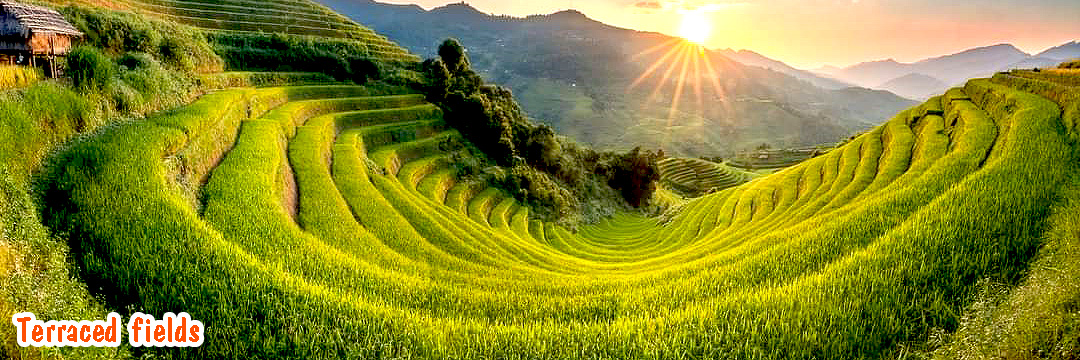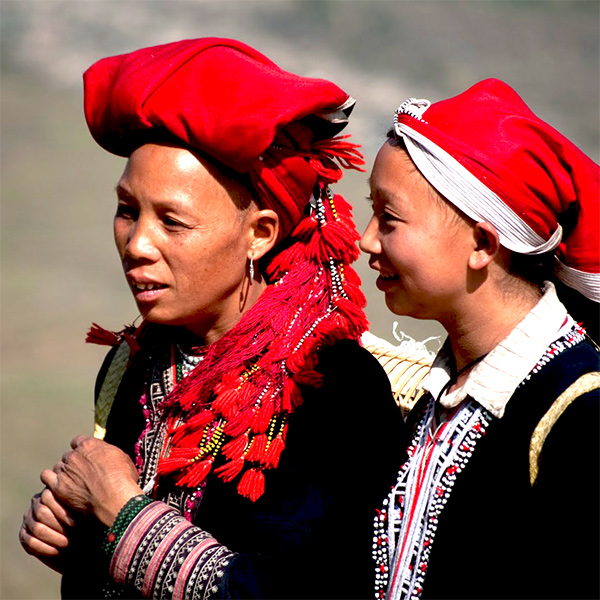

Hanoi Etoco - A travel company in Vietnam © Since 2001
Tucked high in Vietnamese remote northern mountains, the former French military outpost of Sapa offers some of Vietnamese mots colorful experiences. Vietnam's highest peak, the 3,143-meter Mount Fansipan, looms overhead, while the surrounding valleys feature terraced rice paddies and blazing green fields cut by fast-flowing streams.
Ethnic minorities in various styles of traditional dresses - indigo tunics, leggings, elaborate pleated skirts, and silver-studded jackets - stroll up for Sapa bustling weekend markets. People here live as they have for centuries, raising water buffaloes and pot bellied pigs, cultivating paddy, corn and cassava and weaving their colorful clothing. Visit Sapa, one of the rare corners of the world where people traditions continue to flourish and nature reign supreme, you will feel the thrill of discovery Sapa is a scenic spot in northwestern Vietnam, 350km from Hanoi by road and 38km from Lao Cai City. Located at 1,500m above sea level, Sapa lies on the side of the Hoang Lien Son Mountains, 350km northwest of Hanoi. Sapa's flora is diverse, ranging from flowers to tropical fruits; among the most popular fruits produced in Sapa are apples, pears, peaches, and plums.
Sapa has many natural sites such as Thac Bac, Thuy Cung Grotto, Gio Cave, Troi Gate, and Truc Forest. Sapa is also the starting point for many climbers and scientists who want to reach the top of Fansipan Mountain, the highest mountain in Vietnam at 3,143 m. Hoang Lien Son Range is also called the Alps of the North Sea area since Fansipan Mountain is not only the highest peak in Vietnam, but also in the Indochina Peninsula. The pyramid-shaped mountain is covered with clouds all year round and temperatures often drop below zero, especially at high elevations.
Sapa was first discovered by the French in late 19th century. It soon became famous in Indochina for its ideal climate. In colonial times French officials from Hanoi the port city of Haiphong and Hai Duong used to flock to Sapa in summer to escape the unbearable tropical heat in the low-lying land. At that time some 200 detached cottages and villas were built for French colonialists. The most imposing villas were that of the Sixth Bureau, the Governor General and the Metropole hotel, a subsidiary of the Metropole in Hanoi. Time passed with the ups and downs of the nation's history, and now there remain only dozen or so villas. Yet even the existence of this small number of villas can attract keen interest from architecturally minded visitors for their gothic style of architecture with the gracefully curved entrance gates resembling the myth-filled ancient castles of European countries.
A small village of H'mong people about 4 km from Sapa Center. Trekking or going by motorbike, jeep upon request. There is an existing Power Station built by the French next to a very nice stream where you can sit and relax on big stones.
9 km from Sapa Center: trekking down and picked up by motorbike or jeep will take you whole day; 2 ways going by car will take you half day. On the way to Lao Chai & Ta Van, very nice rice paddles are on your view where you can see minorities of H'mong, Day and Dao people who dress in traditional style that is unique in the Northern Region of Vietnam; and explore their daily lives, culture and customs.
15 km from Sapa on the way back to Lao Cai, Tafin is famous for its scenery with mountains and caves, the Black H'mong and Red Dao houses. A Women Union's embroidery house is a place where you can buy a small hand-made gift. Especially, ladies' silver-colored beads and coins will surprise you a great deal. People have always believed that a womans wealth is equal to the weight of coins she carries. Here, the women are beautiful with long locks of hair tied up in a large red embroidered turban. On entering the Red Dao's home, you can see a wooden stove burning all the time in the middle of the house a symbol of a long lasting life and keeping people out of bad lucks and evil spirits.
To and from Tafin, should you take a motorbike or jeep, 3 hours.
Reaching the Silver Waterfall (Thac Bac) by motorbike or car, climbing 100 m high stairs you should continue up to Tram Ton - the highest pass in Viet Nam at 2047 m. A side magnificent views, the bizarre thing is how dramatically the climate changes: on Sapa's side, it is expected to be cold, foggy and nasty while it is sunny and warm on the other side of Lai Chau.
Fanxipan is branded "the Roof of Indochina" at the height of 3,143m, is to be approved as one of the very few eco-tourist spots of Vietnam, with 2,024 floral varieties and 327 faunal species.
The French came to Vietnam and in 1905 planted a landmark telling Fanxipan height of 3,143m and branded it the Roof of Indochina. Very few people climbed to the top of Fanxipan at the time. Since 2017, there is a cable car to the top of Fansipan
Fanxipan, 400 km from Hanoi, is to be approved as one of the very few eco-tourist spots of Vietnam, with 2,024 floral varieties and 327 faunal species. Foreigners like best to book Fanxipan tours between October and December, as this period is more often than not free from the heavy rains that obstruct the jaunt. However, the best time for the trek to the mountain is from the end of February to the start of March, when the flowers all flourish and the climbers may behold the carpets of brilliant blossoms, violets and orchids, rhododendrons and aglaias.
Ham Rong mountain is 1,750 m high and 1.5 km up from the center of Sapa Town, taking you about 2.5 hours round trip trekking.
It has absolutely wonderful scenery of panoramic view of the whole Sapa Town in cloud. You will have a chance to discover large orchid gardens. There is a daily show of ethnic minority groups at 09h00 and 15h00.
Legend has it that in the distance past, all animals lived together in a chaotic environment. One day, Jade Emperor gave an order that every species of animal had to find for themselves an area to live. Having heard the order, they scrambled for a place to reside. The three brothers of dragon who were living in a large lake hurriedly ran to the east but could not find any place, they then ran to the west. The two older brothers ran fast and came to the destination first. The youngest brother ran slowly and strayed into the crowds of lions, tigers and big cats. Fearing that these animals would attack it, the dragon opened its mouth to defense itself. At that time, the order of Jade Emperor was no longer available, so the three dragons petrified. The two older dragons, which were waiting for their brother, face Lao Cai Town, and the youngest one raising its head and opening mouth faces the Hoang Lien Son Mountain Range. The mountain is named Jaw of Dragon
Late in the every Saturday evening. Ethnic minorities from the surrounding villages, especially Red Zdao people, put on their most colorful costumes and head to Sapa's market on Saturday. The girls try to hide in the dark shadows and sing the love songs to attract the boys, who try to find where the songs come from. If the two young people are well matched, they go together into the forest for three days. Back from this escapade, they can get married if they desire. Be quiet and patient to discover it.
This cultural activity has a long history and is still significant in the modern life of the minority people. The Sapa Market is an attractive place for visitors who are keen on exploring traditional cultures
 The Dao minority in Sapa
The Dao minority in Sapa